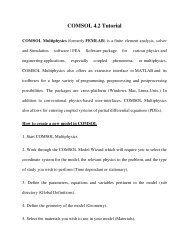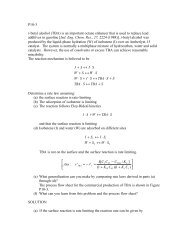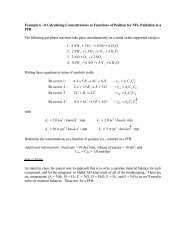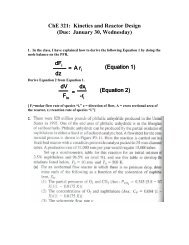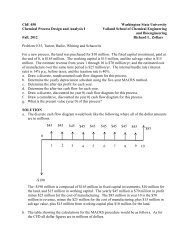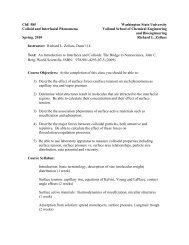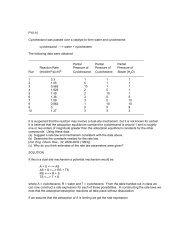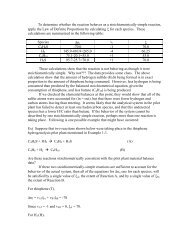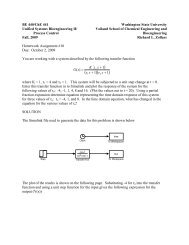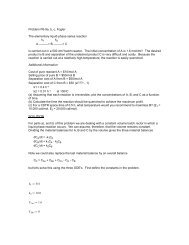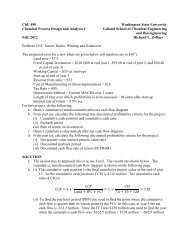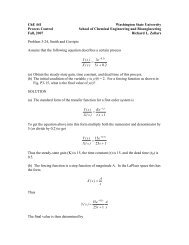P6-8, Fogler Tarzlon is a liquid antibiotic that is taken orally to treat ...
P6-8, Fogler Tarzlon is a liquid antibiotic that is taken orally to treat ...
P6-8, Fogler Tarzlon is a liquid antibiotic that is taken orally to treat ...
You also want an ePaper? Increase the reach of your titles
YUMPU automatically turns print PDFs into web optimized ePapers that Google loves.
<strong>P6</strong>-8, <strong>Fogler</strong><strong>Tarzlon</strong> <strong>is</strong> a <strong>liquid</strong> <strong>antibiotic</strong> <strong>that</strong> <strong>is</strong> <strong>taken</strong> <strong>orally</strong> <strong>to</strong> <strong>treat</strong> infections of the spleen. It <strong>is</strong> effective only ifit can maintain a concentration in the blood-stream (based on volume of body fluid) above 0.4mg/dm 3 of body fluid. Ideally, a concentration of 1.0 mg/dm 3 in the blood would like <strong>to</strong> be realized.However, if the concentration in the blood exceeds 1.5 mg/dm 3 , harmful side effects can occur.Once the <strong>Tarzlon</strong> reaches the s<strong>to</strong>mach it can proceed in two pathways, both of which are firs<strong>to</strong>rder:(1) It can be absorbed in<strong>to</strong> the blood stream through the s<strong>to</strong>mach walls; (2) it can pass outthrough the gastrointestinal tract and not be absorbed in<strong>to</strong> the blood. Both these processes are firs<strong>to</strong>rder in <strong>Tarzlon</strong> concentration in the s<strong>to</strong>mach. Once in the bloodstream, <strong>Tarzlon</strong> attacks bacterialcells and <strong>is</strong> subsequently degraded by a zero-order process <strong>Tarzlon</strong> can also be removed from theblood and excreted in the urine through a first-order process within the kidneys. In the s<strong>to</strong>mach:Adsorption in<strong>to</strong> blood k 1= 0.15 h -1Elimination through gastrointestine k 2= 0.6 h -1In the bloodstream:Degradation of <strong>Tarzlon</strong> k 3= 0.1 mg/dm 3 -hElimination through urine k 4= 0.2 h -1(a) Plot the concentration of <strong>Tarzlon</strong> in the blood as a function of time when 1 dose (i.e., one <strong>liquid</strong>capsule) of <strong>Tarzlon</strong> <strong>is</strong> <strong>taken</strong>.(b) How should the <strong>Tarzlon</strong> be admin<strong>is</strong>tered (dosage and frequency) over a 48-h period <strong>to</strong> be mosteffective?(c) Comment on the dose concentrations and potential hazards.(d) How would your answers change if the drug were <strong>taken</strong> on a full or empty s<strong>to</strong>mach?One dose of <strong>Tarzlon</strong> <strong>is</strong> 250 mg in <strong>liquid</strong> form: Volume of body fluid = 40 dm 3 .SOLUTIONIn solving th<strong>is</strong> problem we need <strong>to</strong> recognize a couple of facts. First we will need <strong>to</strong> draw ad<strong>is</strong>tinction between <strong>Tarzlon</strong> in the bloodstream and <strong>Tarzlon</strong> in other locations (where it <strong>is</strong> noteffective). Let A = <strong>Tarzlon</strong> in s<strong>to</strong>mach, B = <strong>Tarzlon</strong> in the bloodstream, C = <strong>Tarzlon</strong> in thegastrointestine, D = <strong>Tarzlon</strong> degraded by attack on bacterial cells and E = <strong>Tarzlon</strong> in the urine. Thereaction scheme then looks likeA -----> B ------> D\ \\--> C \->EWe are interested in computing C B. The second thing <strong>to</strong> note <strong>is</strong> <strong>that</strong> when dealing with first ordersystems of constant volume (we'll assume constant volume for th<strong>is</strong> since it <strong>is</strong> a <strong>liquid</strong> system) thevolume will cancel out of the equation. For example consider the balance on Adn A /dt = (-k 1 C A - k 2 C A )V = -(k 1 +k 2 )(n A /V)V = -(k 1 +k 2 )n AWe could also multiply th<strong>is</strong> equation by the molecular weight of <strong>Tarzlon</strong> <strong>to</strong> convert the molar units <strong>to</strong>mass units, i.e.,dm A /dt = -(k 1 +k 2 )m ASimilarly for B we getdn B /dt = (k 1 C A - k 3 /MW A - k 4 C B )V
where the MW A term <strong>is</strong> necessary since k 3 <strong>is</strong> given in mass units. Multiplying by V and MW A givesdm B /dt = k 1 m A - k 3 V - k 4 m BThe other balances aredm C /dt = k 1 m Adm D /dt = k 3 Vdm E /dt = k 4 m BNow define the constants, set the initial values and integrate th<strong>is</strong> set of five equations.(a)k 1 := 0.15k 2 := 0.6k 3 := 0.1k 4 := 0.2m Ao := 250V := 40y :=⎛⎜⎜⎜⎜⎜⎝D( t,y)m Ao0000:=⎞⎟⎟⎟⎟⎟⎠⎡⎢⎢⎢⎢⎢⎢⎣k 1 ⋅y 0( )− k 1 + k 2 ⋅y 0− k 3 ⋅V− k 4 ⋅y 1k 2 ⋅y 0k 3 ⋅Vk 4 ⋅y 1⎤⎥⎥⎥⎥⎥⎥⎦
Z := Rkadapt( y, 0, 10, 100,D)To convert the mass of <strong>Tarzlon</strong> in the bloodstream (m B ) <strong>to</strong> concentration divide by the volume ofthe body fluid.ii := 0..100Z ( ii,2)Z ( ii,6):=VNow plot the results for C B .0.6<strong>Tarzlon</strong> Blood Concentration Profile0.4<strong>Tarzlon</strong> Concentration (mg/dm^3)0.200.20.40 2 4 6 8 10Time (hours)b) From the results for a single dose we see <strong>that</strong> the <strong>Tarzlon</strong> blood concentration peaks at about0.598 mg/dm 3 and drops below 0.4 mg/dm 3 after 4 hours. What we need <strong>to</strong> do <strong>is</strong> <strong>to</strong> increase theinitial dose <strong>to</strong> bring the peak concentration <strong>to</strong> 1.5 mg/dm 3 . Let's try twice the dose.m Ao := 500
y :=⎛⎜⎜⎜⎜⎜⎝D( t,y)m Ao0000:=⎞⎟⎟⎟⎟⎟⎠⎡⎢⎢⎢⎢⎢⎢⎣k 1 ⋅y 0( )− k 1 + k 2 ⋅y 0− k 3 ⋅V− k 4 ⋅y 1k 2 ⋅y 0k 3 ⋅Vk 4 ⋅y 1⎤⎥⎥⎥⎥⎥⎥⎦Z := Rkadapt( y, 0, 10, 100,D)Z ( ii,2)Z ( ii,6):=VNow plot the results for C B .1.5<strong>Tarzlon</strong> Concentration Profile<strong>Tarzlon</strong> Concentration (mg/dm^3)10.500 2 4 6 8 10Time (hours)The peak concentration <strong>is</strong> 1.363 mg/dm 3 . So for a 250 mg dose the peak concentration <strong>is</strong> 0.598mg/dm 3 and for an initial dose of 500 mg the peak concentration <strong>is</strong> 1.363 mg/dm 3 . Use a linearinterpolation <strong>to</strong> get an initial dose of 544 mg.m Ao := 544
y :=⎛⎜⎜⎜⎜⎜⎝D( t,y)m Ao0000:=⎞⎟⎟⎟⎟⎟⎠⎡⎢⎢⎢⎢⎢⎢⎣k 1 ⋅y 0−( k 1 + k 2 ) ⋅y 0− k 3 ⋅V− k 4 ⋅y 1k 2 ⋅y 0k 3 ⋅Vk 4 ⋅y 1⎤⎥⎥⎥⎥⎥⎥⎦Z := Rkadapt( y, 0, 20, 200,D)ii := 0..200Z ( ii,2)Z ( ii,6):=VNow plot the results for C B .1.5<strong>Tarzlon</strong> Concentration Profile<strong>Tarzlon</strong> Concentration (mg/dm^3)10.500.50 5 10 15 20 25Time (hours)
The peak concentration of <strong>Tarzlon</strong> <strong>is</strong> now 1.498 mg/dm 3 . The <strong>Tarzlon</strong> concentration does not dropbelow 0.4 mg/dm 3 until after 7.6 hours. So let's take the initial dose and wait 7.5 hours beforetaking a second. If the second dose <strong>is</strong> larger than 250 mg but less than 544 mg we should be able<strong>to</strong> take the peak concentration back up <strong>to</strong> 1.5 mg/dm 3 . After some trials, with a second dose of 395mg we get the results shown below.Z := Rkadapt( y, 0, 7.5, 100,D)ii := 0..100Z ( ii,2)Z ( ii,6):=VZ ( 100,6)= 0.426second := 450m A1 := Z ( 100,1)+ secondy :=⎡⎢⎢⎢⎢⎢⎢⎣m A1Z ( 100,2)Z ( 100,3)Z ( 100,4)Z ( 100,5)⎤⎥⎥⎥⎥⎥⎥⎦D( t,y):=⎡⎢⎢⎢⎢⎢⎢⎣k 1 ⋅y 0( )− k 1 + k 2 ⋅y 0− k 3 ⋅V− k 4 ⋅y 1k 2 ⋅y 0k 3 ⋅Vk 4 ⋅y 1⎤⎥⎥⎥⎥⎥⎥⎦Z1 := Rkadapt( y, 7.5, 15, 100,D)ii := 0..100Z1 ( ii,2)Z1 ( ii,6):=jj := 0..6VZZ ( ii,jj):= Z ( ii,jj)
ZZ ( ii+ 100,jj):= Z1 ( ii,jj)ij := 0..2001.5<strong>Tarzlon</strong> Concentration Profile<strong>Tarzlon</strong> Concentration (mg/dm^3)10.500 2 4 6 8 10 12 14 16Time (hours)Let's try a third dose of 450 mg.m A2 := Z1 ( 100,1)+ secondy :=⎡⎢⎢⎢⎢⎢⎢⎣m A2Z1 ( 100,2)Z1 ( 100,3)Z1 ( 100,4)Z1 ( 100,5)⎤⎥⎥⎥⎥⎥⎥⎦D( t,y):=⎡⎢⎢⎢⎢⎢⎢⎣k 1 ⋅y 0−( k 1 + k 2 ) ⋅y 0− k 3 ⋅V− k 4 ⋅y 1k 2 ⋅y 0k 3 ⋅Vk 4 ⋅y 1⎤⎥⎥⎥⎥⎥⎥⎦Z2 := Rkadapt( y, 15, 22.5, 100,D)
Z2 ( ii,2)( ):=( Z2) ii,6VZZ ( ii+ 200,jj):= Z2 ( ii,jj)ij := 0..3001.5<strong>Tarzlon</strong> Concentration Profile<strong>Tarzlon</strong> Concentration (mg/dm^3)10.500 5 10 15 20 25Time (hours)We could continue th<strong>is</strong> but the cycles are fairly constant. Thus the recommended dosage would bean initial dose of 544 mg followed by 450 mg dosage every 7.5 hours. The 7.5 hour cycle doesn't fitin<strong>to</strong> a 24 hour day so for patient compliance it might be better <strong>to</strong> take a sslightly larger dosage every8 hours (the maximum will be exceeded for a short time)..(c) The different dosages would make manufacture and patient compliance more difficult. A betterdosage level would be one <strong>that</strong> was the same for the initial and all subsequent doses. The otherdrawback <strong>to</strong> the procedure above <strong>is</strong> <strong>that</strong> the cycles go from maximum safe concentration <strong>to</strong>minimally effective concentration. If a patient m<strong>is</strong>sed taking a dose the effectiveness would be zero.If they <strong>to</strong>ok a dose <strong>to</strong>o soon, they would exceed the maximum allowable concentration. In terms ofsafety a dosage regime with smaller cycles would be better. A still better procedure would be <strong>to</strong>give an initial dose then start a constant feed of <strong>Tarzlon</strong>. For example, if a feed of <strong>Tarzlon</strong> equal <strong>to</strong>60 mg/hr <strong>is</strong> started 5.0 hours after an initial dose of 544 mg <strong>is</strong> given the response in the body wouldbe
y :=⎛⎜⎜⎜⎜⎜⎝D( t,y)m Ao0000:=⎞⎟⎟⎟⎟⎟⎠⎡⎢⎢⎢⎢⎢⎢⎣k 1 ⋅y 0−( k 1 + k 2 ) ⋅y 0− k 3 ⋅V− k 4 ⋅y 1k 2 ⋅y 0k 3 ⋅Vk 4 ⋅y 1Z := Rkadapt( y, 0, 5.0, 50,D)ii := 0..50⎤⎥⎥⎥⎥⎥⎥⎦Z ( ii,2)Z ( ii,6):=Vy :=⎡⎢⎢⎢⎢⎢⎢⎣Z ( 50,1)Z ( 50,2)Z ( 50,3)Z ( 50,4)Z ( 50,5)⎤⎥⎥⎥⎥⎥⎥⎦D( t,y):=⎡⎢⎢⎢⎢⎢⎢⎣−( k 1 + k 2 ) ⋅y 0 + 60k 1 ⋅y 0− k 3 ⋅V− k 4 ⋅y 1k 2 ⋅y 0k 3 ⋅Vk 4 ⋅y 1⎤⎥⎥⎥⎥⎥⎥⎦Z1 := Rkadapt( y, 5.0, 100, 100,D)k 4 = 0.2ZZ ( ii,jj):= Z ( ii,jj)ij := 0..100
Z1 ( ij,2)Z1 ( ij,6):=VZZ ( ij+ 55,jj):= Z1 ( ij,jj)ik := 0..1501.5<strong>Tarzlon</strong> Concentration Profile<strong>Tarzlon</strong> Concentration (mg/dm^3)10.5ZZ ( 100,2)= 39.99600 20 40 60 80 100Time (hours)(d) If the drug were <strong>taken</strong> on a full s<strong>to</strong>mach some of the drug would be absorbed by the food. Th<strong>is</strong>would slow the release of the drug in<strong>to</strong> the blood. If the drug could be absorbed through theintestine the effect of the food would be <strong>to</strong> lower the peak height but spread out the release.




